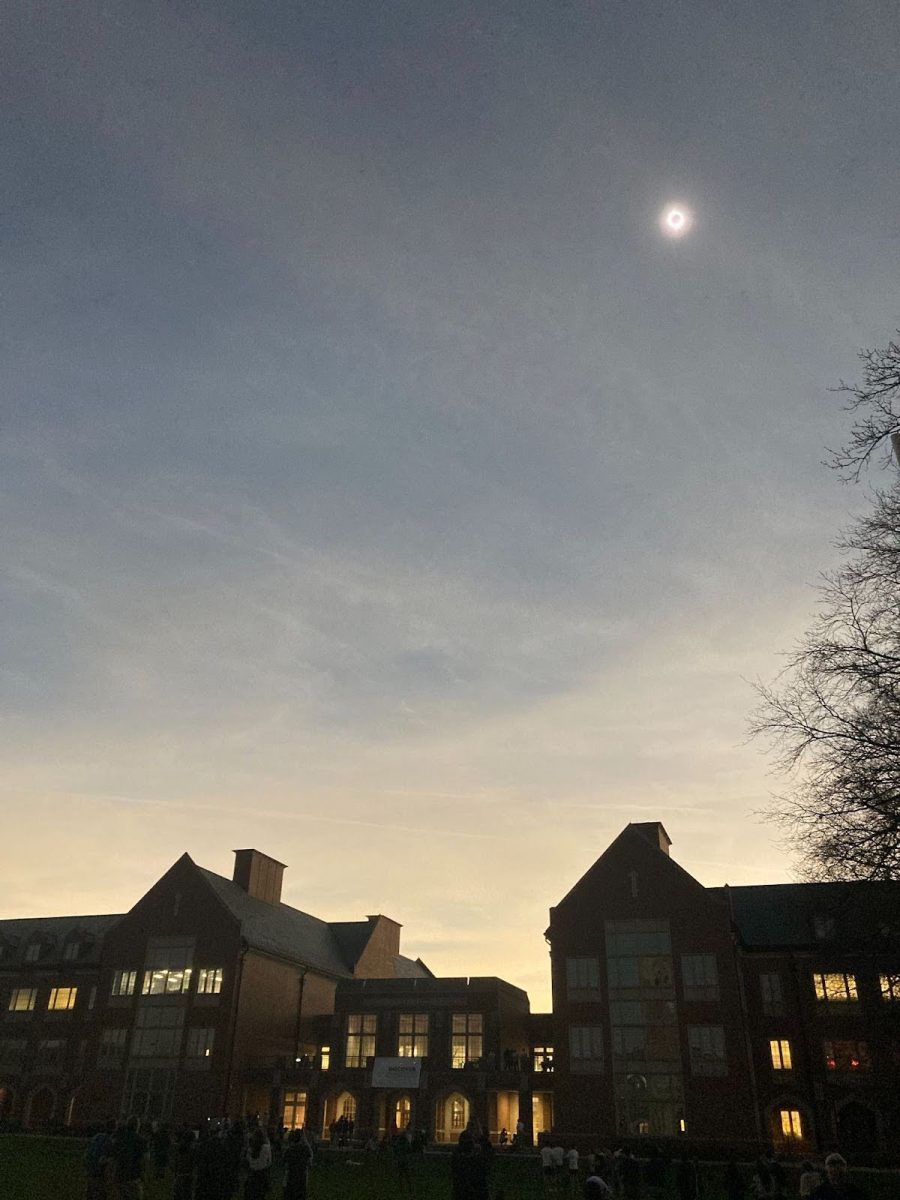On April 8, Student Engagement hosted a solar eclipse watch party on Hamlin Quad where they were handing out free JCU-branded eclipse glasses to community members. In addition to students, staff and faculty getting the opportunity to witness such a phenomenon, people from surrounding communities even came with their families to take in this once-in-a-lifetime event.
“I really loved being able to see ‘a sunset’ and a ‘sunrise’ within minutes,” Lauren Roberts ‘26 shared with The Carroll News. “The whole environment looked so beautiful. During the total eclipse, I loved how everyone on the Hamlin Quad as a community got so excited. It was amazing to be able to witness history together with my friends.”
As stated by Akron Beacon Journal, the eclipse occurred between 1:59 p.m. and 4:29 p.m., with Cleveland being in the path of totality from 3:13 p.m. to 3:17 p.m. As John Carroll was beginning to go dark, the entire watch party erupted into loud cheering as the moon covered the sun. Many people were holding up their cameras to snap pictures in as many angles as possible, especially during complete totality.
“It was definitely one of the most gorgeous and coolest things I have ever experienced,” Julia Sansoterra ‘26 said. “It was so amazing to see the sunspots and sun’s corona through the telescopes. I am so grateful to have been able to see the eclipse in its entirety, and to see how dark it got during totality.”
Sansoterra continued with “I think it was absolutely incredible, and to be able to experience it as a college student with all of my friends on such a beautiful campus was an unforgettable experience.”
In addition to eclipse glasses, stickers, candy and a caricature drawing artist provided by Student Engagement, there were several tents set up with different experiments that were supervised by professors from the physics department. Each was collecting data based on the activity from the solar eclipse.
Each station had at least one experiment running, which was displayed on large monitors. All of them were measuring the intensity of the sunlight versus time. Right before the eclipse began, a computer read the light intensity every second from a wireless light meter that was purchased just for this event. To ensure effective data was gathered, the setups were duplicated at all tents. One of the tents also collected data from a wireless thermometer mounted away from the crowds. The data was plotted in real time on the monitors for everyone to see.
Each tent also had some viewing activities, including make-your-own pinhole cameras. Dr. Jeffrey Dyck’s tent had a telescope equipped with a solar filter, which was similar to the eclipse glasses. This made it safe to view the sun directly through the eyepiece as the moon made its transit across. The other tents had an image projection onto a screen so the eclipse could be seen easily.
“My tent was very busy most of the time, sometimes with a line to get access to the telescope,” Dyck told The Carroll News. “People definitely said it was very cool to see the sun like that, and were very appreciative. It was fun for me to help the event be more interactive and I think it helped make the otherwise pretty slow process before and after the few minutes of eclipse totality more interesting.”
“Based on the number of people who came up to our tents, I think we had a good reaction from the community,” Dr. Benjamin Grossman-Ponemon told The Carroll News. “Students, faculty and staff came up to ask questions about our equipment and about the eclipse itself. We also had a good response from local community members, who were also very excited about the eclipse.”
Thomas Fogle ‘27, an engineering physics minor, visited all of the stations several times. When asked about his favorite booth and why, he stated the following to The Carroll News:
“It’s a hard pick, but I might go with [Grossman-Ponemon’s]. I liked seeing the very definite U shape that was made once the moon had passed the sun and it was really neat to see how the temperature dropped as it got darker. The other ones were all really neat as well though.”
Madison Maziarz ‘24 is the CEO of the student-ran Food Buggy that was also at the solar eclipse watch party.
“As the CEO of the Food Buggy, my primary focus is leading our team in fulfilling our nonprofit mission to serve homelessness in the Cleveland community,” Maziarz said. “We run the Food Buggy business from top to bottom; from planning, to marketing, to purchasing materials, to staffing, to working our events, we do it all! My goal this semester was to run as many quality events as possible to enable us to financially support our social mission events.”
In terms of what was served to the JCU community, Emily Medina ‘27 told The Carroll News “It was walking taco bowls! There was a choice of Fritos or Doritos with it. Students ate free and [staff/faculty] had to pay for their food.”
The Food Buggy also gave out chocolate covered treats. Maziarz added that “We also had a variety of beverages and were handing out the Eclipse Chips.” In total, 122 students and around 30 other JCU community members were served.
Students are already looking forward to 2044, the next time the United States will see any path of totality. Since Montana is part of where that solar eclipse would happen, some are talking about possibly making the drive there to experience this all over again.



